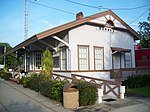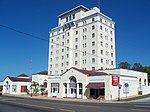Lake Hamilton, Florida
Lakes of Polk County, FloridaTowns in FloridaTowns in Polk County, FloridaUse mdy dates from July 2023

Lake Hamilton is a town in Polk County, Florida, United States. The population was 1,537 at the 2020 census. It is part of the Lakeland–Winter Haven Metropolitan Statistical Area. The town is named after the lake itself: Lake Hamilton, which is one of the many lakes in the Chain of Lakes. Also, Middle Lake Hamilton and Little Lake Hamilton are located nearby. From 1964 through the 1970s, Hurricane Aircats, military airboats used by the US Army in Vietnam, were manufactured in Lake Hamilton. The airboats were made by Hurricane Fiberglass Products Company, an airboat and fiberglass manufacturer based in the neighboring town of Auburndale.
Excerpt from the Wikipedia article Lake Hamilton, Florida (License: CC BY-SA 3.0, Authors, Images).Lake Hamilton, Florida
West Bryant Avenue,
Geographical coordinates (GPS) Address Nearby Places Show on map
Geographical coordinates (GPS)
| Latitude | Longitude |
|---|---|
| N 28.046666666667 ° | E -81.622222222222 ° |
Address
West Bryant Avenue 185
33851
Florida, United States
Open on Google Maps








